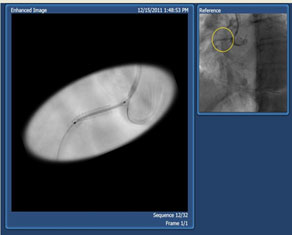GPU-Accelerated Diagnosis and Treatment for Heart Disease
This week's Spotlight is on Eldad Klaiman, a signal/image processing engineer at Volcano.
Eldad works on an R&D team that develops software to assist physicians who treat coronary disease
in real time with devices such as wires, catheters and stents. Eldad says: "CUDA helps me make the impossible a bit more possible."
This interview is part of the CUDA Spotlight Series.
Q & A with Eldad Klaiman
NVIDIA: Eldad, what is your role at Volcano?
Eldad: Being a part of a very small and close-knit R&D team, I get to do practically a bit of everything, but my main responsibilities include design and implementation of real-time image processing algorithms.
NVIDIA: Who are the end-users of Volcano technology?
Eldad: The Sync-Rx System is an add-on online image processing workstation for coronary catheterizations. This means that it is used by the Cath-Lab team which consists of doctors, nurses and technicians. The main beneficiaries of the system are not these users, but the patients undergoing the procedure.
NVIDIA: What is the function of a coronary device?
Eldad: The coronary arteries surround the heart and supply it with oxygen and vital materials. Obstruction of blood flow in one or more of these arteries, e.g. by thrombosis or plaque, can result in Myocardial Infarction (also known as a heart attack) which is basically death of heart muscle due to oxygen deprivation. Coronary devices are the devices inserted into the body in order to diagnose or treat coronary disease. This type of device includes wires, catheters, balloons, stents, filters, etc.
NVIDIA: Tell us about the process a physician uses to insert coronary devices.
Eldad: In a nutshell, devices are inserted into the artery, either via the arm or the groin, and maneuvered through the blood stream until they reach the diseased section of the coronary artery. Then, a balloon and/or stent are positioned and inflated into place over the lesion in order to restore proper blood flow in the vessel.

Video showing the Sync-Rx System at work
This procedure is done under X-Ray fluoroscopy, in which the arteries themselves are invisible. In order to visualize the arteries for a few seconds, an angiography is produced by injecting radio-opaque dye into the bloodstream, but since this dye is poisonous, it must be used sparingly. To further complicate things, the coronary vessels are constantly moving with the heartbeat.
All in all, this would be comparable to trying to insert a key into the keyhole of a door mounted on a pendulum, in the dark, where the only available source of light is a camera flash.
NVIDIA: How does Volcano technology help make this process safer?
Eldad: Our system assists the interventionist throughout the procedure. During the diagnostic phase, we automatically detect the contrast agent injections and select the best frame for analysis. We allow the physician to perform one-click, online, QCA (Quantitative Coronary Analysis) measurements on the X-Ray image to help assess the dimensions and severity of the lesion.
During the therapeutic phase we automatically detect the balloon or stent inserted into the coronaries and display a stabilized enhanced image of it to the user. The physician can then position the stent while looking at an image that is not constantly moving and also inspect the quality of the balloon inflation or stent deployment by looking at the enhanced image.
NVIDIA: Why did you decide to use GPUs?
Eldad: X-Ray streams are captured at a rate of about 20 fps, and the physician needs to see results online and in real time. We needed to accelerate our code, and we needed to do it without too much delay to our development. CUDA has a fast learning curve and GPUs are easy to purchase and integrate into an existing system.
NVIDIA: How did you become interested in computer vision?
Eldad: Actually, quite by chance. My first job after school was with a company doing microscopy imaging and it kind of grew on me..
NVIDIA: What's your favorite feature in CUDA?
Eldad: I like the simplicity of the code and that it is maintainable and easy to understand. CUDA helps me make the impossible a bit more possible.
Bio for Eldad Klaiman
http://www.linkedin.com/in/eldadk
Relevant Links
http://www.sync-rx.com/
http://www.volcanocorp.com/
Contact Info
Eklaiman (at) volcanocorp (dot) com


